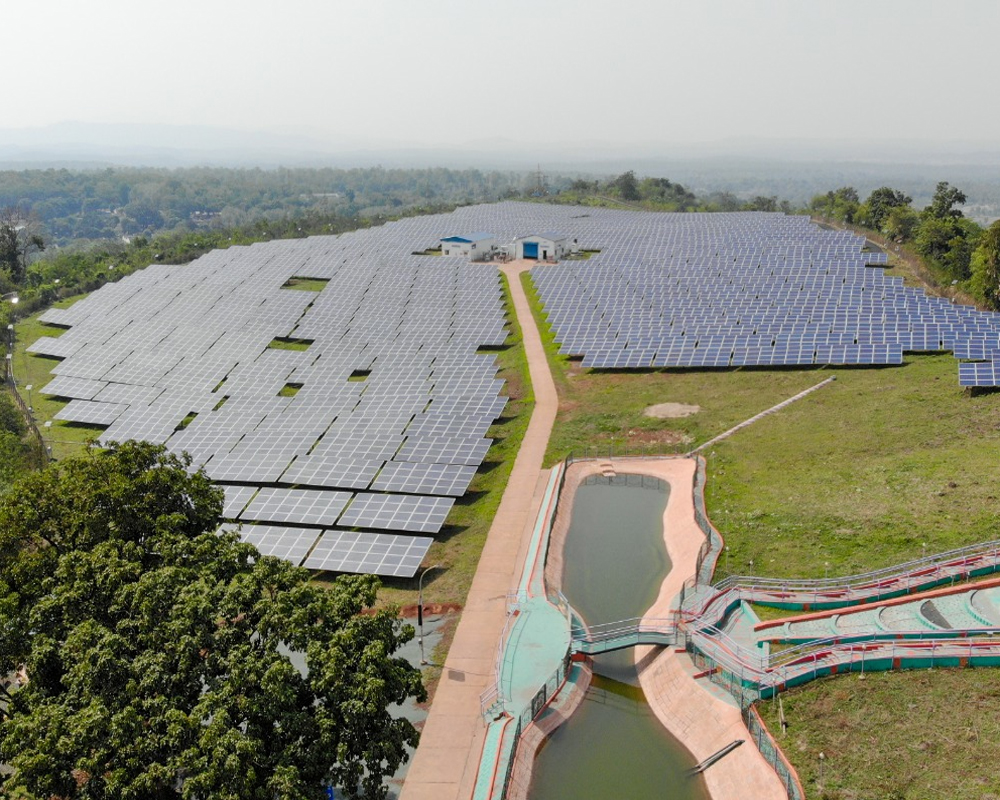Giving the much needed fillip to clean energy, Jharkhand Government today rolled out its ambitious Solar Energy Policy-2022 that aims to achieve a capacity of 4,000 mw of solar energy in the next five years!
Tata Steel on its part is already contributing its bit to boost green energy by generating 3 mw of solar energy at its Noamundi iron ore mines in West Singhbhum district of Jharkhand since 2017.
Spread over 13 acres of land as many as 12,480 solar panels are generating the clean energy simultaneously addressing the concerns for climate change. This is the first solar power plant of this size in a mining location in Asia and is expected to reduce CO2 emissions by 3,000 tonnes every year.
Believing in sustainable development since its beginning, Tata Steel embarked upon the idea to install solar energy since it was facing regular power cuts at its Noamundi mines, which is almost 100 year old. The iron ore deposits were discovered at Noamundi in 1917 and today the mines cover an area of 1,160 hectares with a production capacity of 10 million tonnes per annum.
The state run Jharkhand State Electricity Board (JSEB) was the only source of power supply to run the mine and the township. The combined daily requirement of power was around 13 MVA per day ~ 11MVA for mines and 2MVA for the township. However, due to capacity and distribution network constraints, the supply was unfortunately erratic and unreliable at times resulting in either power failure, restriction or tripping on a daily basis. The balance power requirement was met through multiple diesel generator sets.
Talking to the pioneer, Atul Kumar Bhatnagar, General Manager, OMQ Division, Tata Steel, said after doing a detailed study of their requirement, existing technology and a survey of the local topography, they found commissioning the solar plant was the most cost effective and feasible.
Elaborating on sustainability, the Tata Steel way, Bhatnagar said their company has always been dedicated to preserving, enhancing, and restoring biodiversity in its operational regions as part of its efforts to advance sustainability. Tata Steel’s Noamundi Iron Mine (NIM) has taken several other steps towards sustainability, he said.
Let alone producing the green energy to meet its requirements, they have also started rainwater harvesting and restoration of mined-out areas to their original natural habitat after the mining is complete.
Noamundi is divided into six watersheds with a total harvesting potential of 5.8 million m3 per year. Based on available area and runoff potential, rain water harvesting structures in five different areas were developed with check dams, saucers ponds, gully plugs, gabion structures are made to stop the runoff water from area and harvested to augment the ground water level of area.
So far 126 hectares has been reclaimed through afforestation and as many as 23,876 saplings have been planted in the financial year 2022 by different methods like Miyawaki Plantation method, which involves planting two to four trees per square metre. Miyawaki forests grow very quickly, are self-sustaining and help to lower temperatures in concrete heat islands, reduce air and noise pollution, attract local birds and insects and create carbon sinks. Last month, a total of 2,000 saplings were planted on World Environment Day.
Tree Transplantation is another drive in the series of sustainability initiatives, where 3,823 trees have been transplanted at Hill 1 and 2 of Noamundi iron mine lease area. Transplanting or replanting is the process of relocating a plant from one site to another in an agricultural field or garden. Tree transplants allow plants to have longer growing seasons.
Bird Niche Nesting and Herpetofaunal Habitat are two examples of unique projects to restore faunal species. In order to improve the breeding of hole nesters and thereby boost local biodiversity, artificial nest boxes are installed. A total of 540 artificial nest boxes are installed at afforestation and township areas of Noamundi. In order to provide herpetofaunal habitat for reptiles at the mine restoration sites, waste wood generated during mine clearing and waste rocks and boulders created during ore extraction are strategically put in the plantation area and placed separately in the semi open zone.


























